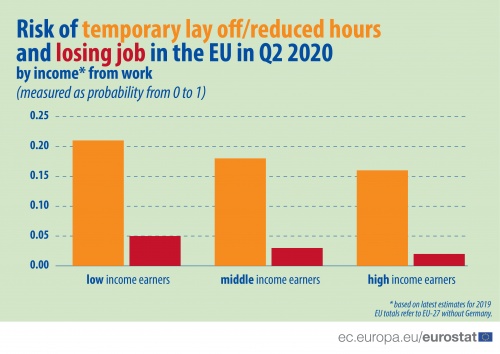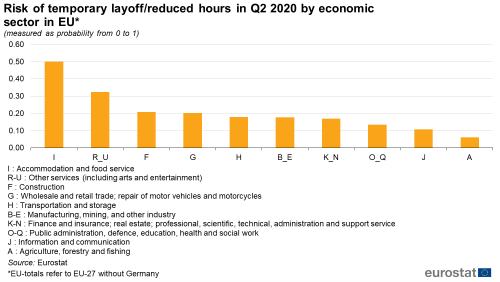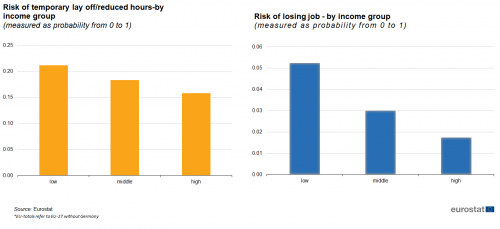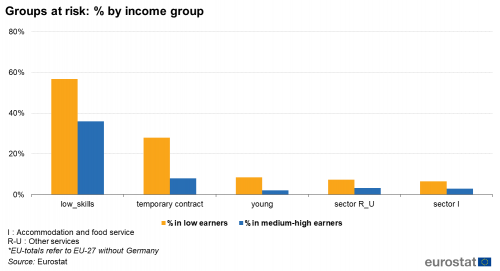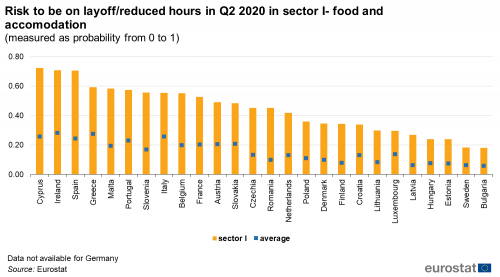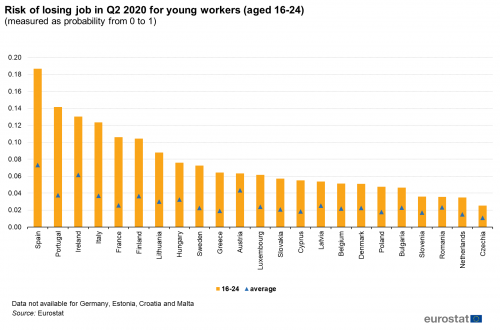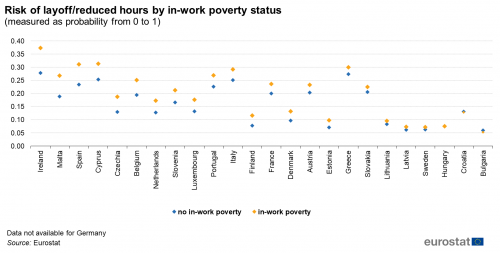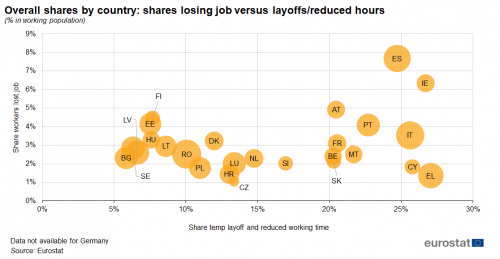COVID-19 labour effects across the income distribution
Data extracted in October 2020.
No planned update.
Highlights
Inequalities of COVID impact on labour and income in the EU: low income workers more likely to lose their job or to be on layoffs.
Workers most hit by the COVID crisis, such as young, low skilled, workers in accommodation and food sectors are often overrepresented in the low income group.
Innovative methods to produce evidence on income distribution in a time of rapidly evolving crisis
In the current crisis related to COVID-19, it becomes essential to provide earlier information to enable policy makers to assess the effects on income distribution in 2020.
In the standard estimation process, flash estimates are based on the estimation of two main impacting factors: 1) the evolution of the labour market and 2) the impact of government measures in terms of benefits and taxes simulated via EUROMOD.
This analysis covers the labour market part of the standard nowcasting methodology extended to 2020. For more details on indicators and methodology, see data sources below. It highlights the most at risk categories given the evolution observed in the latest detailed labour market data available for 2020[1] and its potential effects on income and poverty.
The changes on the labour market in 2020 in the EU considered most relevant for the purpose of our analysis are the increase in the number of workers losing their job and the sharp drop in working hours due to the lockdown[2]. These overall trends are translated into distributional information by assessing the risk of individuals either losing their job or having reduced working hours (which can range from people on layoff[3] or people working part time) at the peak of the COVID crisis in quarter 2. This risk is then correlated with their relative position in the income distribution in 2019 before the crisis. At the income level, the first risk would translate by the loss of income from work, while in the second case the worker is likely to enter wage compensation schemes put in place by the different Member States to buffer the effects of the lockdown.
Full article
A EU level overview
The risk of income loss is concentrated…
In general the “risk” of facing a loss of income and deeper poverty has different patterns across the two dimensions analysed (layoffs/reduced hours versus losing job) and varies substantially across age categories, economic sectors and countries. While the lay-offs/reduced hours concern millions of workers in the EU[4] with very large shares across countries, the effect on unemployment was mitigated by the wage compensation schemes.
…in some sectors of activity
The COVID crisis and the temporary lay-offs have a strong sectorial dimension. The highest risk for a worker to be on temporary layoff in the EU is linked to the accommodation and food sector.
…on some profiles most likely to lose their job in the wake of the crisis
While in general the risk of losing their job is at a lower level, we can note strong disparities between categories of workers. The risk of losing their job was higher for temporary workers, the young employed (aged 16-24) and low skill occupations.
…on those already vulnerable before the crisis
While temporary layoffs during the lockdown are widely spread, the risk of losing the job is much more limited. However, both labour risks are highly unequal across the income distribution with vulnerable individuals (i.e. lower income from work) being more likely to experience further income losses.
…on people cumulating the risk factors
The young, low skilled and accommodation and food sector workers are often overrepresented in the low-income earners group in many countries.
Finally, the situation differs from country to country
Finally, a country comparison brings evidence of a differentiated geography of labour risks in the EU. It is important to note not only that certain countries have higher labour risks but these are also more concentrated in the left part of the income distribution with a potential impact on poverty and inequality. In addition, countries with a larger at-risk of poverty rate for the working age population (18-64) are more likely to be further affected by the COVID crisis, which is essentially a labour market shock. In the next section more information at country level is provided.
A more in-depth cross-country analysis
Linking labour information on the COVID risks for the population at work with income data allows us to answer several questions: which are the countries and the categories of workers most affected according to the two dimensions of interest? How is the labour market shock likely to affect different income groups across EU countries?
While the profiles of workers at risk are similar across the EU, some countries have higher risks
In most countries there is some co-presence of labour risks, with similar sub-groups affected in most countries: certain economic sectors of activity, young or low skilled workers as well as those on temporary contracts.
When analysing the risk to be on temporary layoff or have reduced working hours the most relevant dimension in the current crisis is the economic sector. The most affected sector in almost all countries is sector I-Food and accommodation. In several countries the second most affected are other services (category “R_U”, mainly due to category R- arts and entertainment). In some countries, workers have faced high risks also in the construction and transportation fields.
As already shown at EU level, persons with temporary contracts but also young (16-24) and low skilled workers were more likely than other categories to lose their job in the second quarter of 2020. In both Figures 6 and 7, the bars represent the average risk of various groups of workers to lose their job, while the blue markers represent the overall average risk in the country. We note that young workers have higher probabilities to lose their job in countries such as Spain, Portugal, Ireland, Italy and France. Low-skilled workers are most at disadvantage in Spain, Ireland, Austria, Finland and Hungary.
With the most vulnerable categories of workers more exposed to labour risks and further income losses
The second step of the analysis aims at providing a combined perspective of two important risk areas: labour and income. Drawing from the evidence detailed in the first section of the paper, we now propose a deeper insight on some of the most affected categories of workers during the COVID crisis. How are these categories positioned in the income distribution and how vulnerable are they to the labour market shock across different countries?
Given that our analysis focuses on labour effects, we refer just to income from work, defined as wages plus income from self-employment. We can assess the risks linked to the lockdown measures across three main income groups: low income earners comprise individuals in deciles 1, 2 and 3; the middle group comprises deciles 4, 5, 6, 7; deciles 8, 9 and 10 define the high income category.
In Figure 8, the risk to be on layoff/ have reduced working time is displayed by income group. Countries are ranked according to the largest difference between the high and the low income group. In almost all the countries, the orange marker is above the blue one, indicating that low-income earners face higher risks to be on temporary layoff or have reduced working hours[5] . Furthermore, the most affected countries are those showing the largest gap between the two groups on the left.
Similar conclusions can be drawn from the data presented in Figure 9, which assesses the risk by the at-risk-of-poverty status. Workers already below the risk poverty threshold (60% of the national median disposable income), show for many countries higher risks to suffer income losses due to layoffs/reduced hours in quarter 2.
The probability of losing the job is generally lower than the probability of working less hours. Figure 10 shows how this probability is distributed across income groups. Countries on the left present higher risks for workers at the lower end of the income distribution. In the right part of the chart there are countries for which the probability of losing the job does not show particular differences between high and low income earners[6].
In some countries, for workers below the “at risk of poverty” threshold (Figure 11), the data show higher probabilities of losing their job, compared with workers with higher incomes.
However, the distributional impact of the COVID-19 crisis is likely to differ across countries…
The distributional impact of COVID-19 is likely to differ across countries. The impact is likely to be higher for countries where the labour risks are pronounced, concentrated on vulnerable categories and the working age population has a higher risk of poverty.
Figure 12 displays the overall shares of workers by country along the two dimensions analysed throughout the present paper. Overall, we can note that a large number of countries are characterised by a high reduction in working time and a lower share of workers that lose their job. The size of the bubble refers to the at-risk-of-poverty rate (AROP) for the working age population (18-64) based on estimates of income for 2019[7] . Greece, Italy and Spain have a high at-risk of poverty rate for this age group and therefore are more likely to be further affected.
In both dimensions labour risks are highly unequal with a larger impact for low earners. In general, the sub-groups at risk of losing their job identified throughout the paper have a much higher prevalence in the “low income group”. Figures 13 and 14 below show that the share of young or low skilled is higher in the low earners group than in the rest of the working population. Countries are ordered by the difference in the prevalence for these categories between the low income group and the rest. Estimates are based on the SILC 2018 file “updated” to the 2019 income situation.
In Figure 15 we analyse more in depth the sectors most affected by the confinement measures and temporary layoffs. We cumulate the sectors most affected in each country at the peak of the lockdown in quarter 2. We note that also in this case the share of sectors at risk is higher in the low income group. In the short term income effects for the workers on temporary layoffs or reduced hours are likely to be mitigated by government support schemes. But many of these workers are likely to face a loss of income and deeper poverty, with a dispersed degree of impact across sectors and countries.
Conclusions and follow up estimates 2020
This is a first analysis assessing the risks and vulnerability of different categories of workers most affected by the COVID-19 crisis. Risk refers to the probability of losing their job or suffering layoff/reduced working hours, while vulnerability is related to the relative position in the income distribution.
The labour risks impacted the whole working population, but in most EU Member States the low-income earners present higher risks for both being on layoff and losing their job. This is also the case for workers below the risk poverty threshold (60 % of the national median disposable income) in a large number of countries. In general, this means that the labour market shocks triggered by the sanitary crisis have a stronger impact for those categories of workers that are already in a position of disadvantage.
We have highlighted some general patterns across the EU concerning the two risks analysed. The analysis also shows that the consequences of the pandemic at social and economic level may be different across countries. For instance, in countries such as Spain, Italy, Cyprus, Ireland we note stronger effects for the left part of the income distribution. However, for quantifying the effects on the main income indicators the analysis needs to integrate the impact of temporary policy measures introduced in different countries in order to support households’ income and workers affected by the COVID economic shutdown. The full impact will be consolidated in a later stage when the EUROMOD model will be available.
Feedback
To help Eurostat improve these experimental statistics, users and researchers are kindly invited to give us their feedback by email
Source data for tables and graphs
Data sources
Main definition of indicators
Main indicators for assessing labour market risks
The indicator lose the job is built based on the longitudinal Labour Force Survey data in quarter 2. We consider a person employed in quarter 1 loses the job in two different situations 1) if the employed person transitions to unemployment defined according to the ILO definition or 2) if the employed person transitions to inactive but remains close to the labour market or the self-defined status is unemployed. Three categories of discouraged persons are identified based on whether they are or not available to start a job, their willingness to get a job and their approach to seek employment, similar to the labour market slack indicator. Overall, the later category refers to those persons who were without work and available for work but did not look for work, believing that they have no chance to get employment. There was a clear increasing trend in this category for most countries during quarter 2, as it is likely that individuals could not search for work or were not available due to the lockdown. These are not counted as unemployed according to the ILO concept but are included in our lose the job indicator.
The second indicator for labour market risks is essential for any microsimulation exercise in the current context. It is composed of a) temporary layoffs or people absent from work and b) people with reduced working hours. One of the immediate and tangible effect is the reduction in the number of hours actually worked by employees or even temporary cessation of activity in many sectors of the economy. When available the explicit variable on absence due to COVID is used. It is included on an exceptional basis in the second quarter of the LFS survey in some countries. If not available, a derived indicator on absences is computed based on core LFS variables. The later option of the indicator was validated using two criteria: 1) most countries had a larger than ten fold increase between Jan and April for absences in these categories 2) it was rather close to the COVID question on absences for countries where the explicit question was asked.
Methodological note
The update of labour in the standard flash estimates methodology is either based on reweighting or labour transitions at individual level. The first consists in the derivation of a new vector of sample weights in order to meet control totals for the policy simulation year for a set of main socio-demographic variables (Immervoll et al., 2005). In the second changes in employment are modelled by explicitly simulating transitions between labour market states (Figari et al., 2011; Fernandez Salgado et al., 2013; Avram et al., 2011). In the case of the flash estimates this is a country dependent choice based on the ability of the model to accurately capture SILC changes in the past.
For the analysis of the COVID effects in 2020 this methodology was modified in order to take into account specific factors in the current crisis. The first choice was to rely exclusively on individual labour transitions, a methodology preferred in the case of a labour market shock. This article presented the first results for the probability analysis that is at the core of the methodology for modelling labour transitions.
We model via a logistic regression at individual level for all countries the probabilities of losing the job or having a reduced working time (including workers on temporary layoffs or reduced working hours). The main explanatory variables used in the model are age group, sex, economic sector, occupation and type of contract (temporary vs permanent). Please see Table 1 for the detailed description. Probabilities are finally imputed in the baseline SILC file using the common labour and demographic characteristics. The baseline SILC file used for this risk analysis has income and labour variables updated to 2019 (the same microdata file used for the flash estimates 2019). The labour information is then updated from 2019 to 2020 based on the aforementioned probabilities. This allows “to distribute” the labour risks for workers and households at different parts of the income distribution. As the first results showed this is particularly important in the current crisis. The actual transitions and the related simulation of benefits and taxes will be included in a second stage. This will allow the estimation of main income indicators beyond the market incomes.
Context
In the current extraordinary context of the pandemic and the related lockdown, it becomes essential to provide earlier information to enable policy makers to assess the first effects on the income distribution in 2020.
EUROSTAT already released this year flash estimates on income and poverty, but they refer to income year 2019. This article presents the first experimental results linking the labour market impact of COVID-19 on the most affected categories of workers with their income situation. The labour shock impacted the whole working population but in most EU countries labour risks are highly unequal across the income distribution with vulnerable individuals being more likely to experience further income losses.
It should be noted, however, that this analysis relies on modelling and it therefore incorporates a high level of uncertainty and partial information. The full impact will be consolidated in a later stage when the information on temporary policy measures introduced in different countries in order to support households’ income and workers will be available.
Direct access to
Main tables
Data is based on Eurostat calculations.
Database
The data used in this report is based on Eurostat estimations. For microsimulation, the information set that entered includes the EUROMOD microsimulation model combined with the latest EU-SILC users' database (UDB) microdata file and/or national SILC microdata available at the time of production. This is enhanced with the latest information on labour from the reference period (2020) – the quarter 2 Labour Force Survey (LFS).
EU-SILC further information:
Income, social inclusion and living conditions
EU statistics on income and living conditions (EU-SILC) methodology
EUROMOD, the European Union tax-benefit microsimulation model, is maintained, developed and managed by the Institute for Social and Economic Research (ISER) at the University of Essex and the Joint Research Centre (JRC) in the European Commission, in collaboration with national teams from the EU Member States.
EU-LFS further information:
For more in-depth information on EU Labour Force statistics in 2020 that were used in our estimations please consult the below links:
Dedicated section
Experimental statistics on income inequality and poverty indicators
Methodology
The standard methodology for producing flash estimates relies on microsimulation flash estimates . More information can be found here.
Visualisations
Notes
- ↑ The reference period for the labour market information throughout this article is the 2nd quarter of 2020 based on the Labour Force Survey.
- ↑ See News Release
- ↑ Completely absent from work though having a job.
- ↑ Estimations at EU level are based on 26 countries, excluding Germany. Labour Force Survey data for Germany was not available.
- ↑ The difference is statistically significant with the exception of Bulgaria, Romania and Sweden.
- ↑ This difference is not statistically significant for Romania, Czechia, Denmark and Latvia.
- ↑ For national flash estimates where in-work poverty is not available the level of income for 2018 is used.
